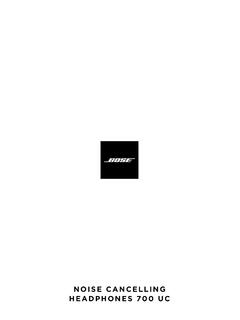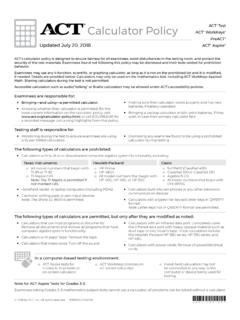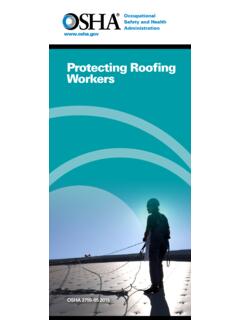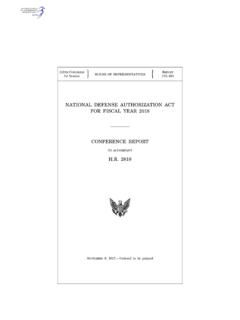Transcription of DEPARTMENT OF DEFENSE DESIGN CRITERIA STANDARD …
1 MIL-STD-1474E 15 April 2015 SUPERSEDING MIL-STD-1474D 12 February 1997 DEPARTMENT OF DEFENSE DESIGN CRITERIA STANDARD noise LIMITS AMSC 9542 AREA HFAC Distribution Statement A: approved for public release; distribution is unlimited METRIC MIL-STD-1474E ii FOREWORD 1. This STANDARD has been approved for use by all Departments and Agencies of the DEPARTMENT of DEFENSE . 2. This STANDARD provides specific noise limits and other requirements to equipment designers and manufacturers. It is intended to cover typical operational conditions. Required noise limits shall not be exceeded if the materiel is to be acceptable to the procuring activity. 3. This STANDARD specifies the maximum permissible noise levels produced by military systems and the test requirements for measuring these levels.
2 This document is based on the provisions of DEPARTMENT of the Army Pamphlet (DA PAM) 40-501, Chief of Naval Operations Instruction (OPNAVINST) , OPNAVINST , OPNAVINST , Air Force Occupational Safety and Health STANDARD (AFOSH STD) 48-19, and AFOSH STD 48-20 for noise exposure CRITERIA and Military STANDARD 1472 (MIL-STD-1472) for communications CRITERIA . This STANDARD is neither a hearing damage risk criterion nor a hearing conservation criterion. It is a set of DESIGN CRITERIA . 4. Due to the possibility of unpredictable interactions of various noise sources during military operations, all new equipment, whether newly designed or purchased, should emit the lowest feasible noise level. Product and component selection CRITERIA and procurement decisions should consider noise produced by equipment and, where possible, provide for comparison of noise levels between comparable products through databases such as the National Aeronautics and Space Administration (NASA) Buy Quiet program ( ) or the National Institute for Occupational Safety and Health (NIOSH) database for powered hand tool noise and vibration ( ).
3 5. The preferred method of noise control is source reduction, followed by enclosure or other engineering controls, use of personal protection equipment, and administratively limited exposure as the least preferred method. The effective noise reduction (level of protection) provided by hearing protective equipment should be considered when evaluating personnel exposures in accordance with DoD and Service policy (DODI and derivative documents) and Occupational Safety and Health Administration regulations (29 CFR ). Prior to exposing personnel to known system-related risks, the residual risks are accepted by the appropriate level of management. Potential impacts on operational safety including hostile detection and disruption of mission-essential communications should be considered in DESIGN requirements, system specifications, and test and evaluation CRITERIA .
4 6. This military STANDARD applies to all operations regardless of duration and availability of recovery periods; therefore, the CRITERIA contained herein are more conservative than the Occupational Safety and Health Administration (OSHA) requirements and are to be used whenever feasible in lieu of OSHA standards. DEPARTMENT of DEFENSE (DoD) policy can be found in DEPARTMENT of DEFENSE Instruction (DODI) and DODI MIL-STD-1474E iii 7. Comments, suggestions, or questions and any pertinent data which may be of use in improving this document should be addressed to Commander, Army Aviation and Missile Research Development and Engineering Center, ATTN: RDMR-SET, Redstone Arsenal, AL 35898-5000 or emailed to Since contact information can change, users may want to verify the currency of this address information using the Acquisition Streamlining and Standardization Information System (ASSIST) Online database at MIL-STD-1474E iv TABLE OF CONTENTS PARAGRAPH PAGE 1.
5 Introduction ..1 Scope ..1 Applicability .. 1 Purpose .. 1 2. Applicable Documents ..1 General ..1 Government documents .. 2 Specifications, standards, and handbooks ..2 Other Government documents, drawings, and publications ..2 Non-Government publications .. 3 Order of precedence .. 5 3. Definitions ..5 Definitions ..5 Auditory Hazard Assessment Algorithm for 5 Cone index .. 5 Microphones .. 5 Abbreviations .. 5 4. General Requirements .. 7 Systems and subsystems .. 7 Total system noise .. 7 Component noise .. 8 Government furnished equipment .. 8 noise hazard .. 8 Protection from hazardous noise .. 8 noise hazard signs .. 8 noise hazards .. 10 Speech communication .. 10 Predictors of speech intelligibility.
6 10 Frequency range .. 11 Modified rhyme testing .. 11 MIL-STD-1474E v Pulsating equipment .. 12 Reporting by Government agencies .. 12 Systems, equipment, and facilities .. 12 Steady-state noise .. 12 Impulsive noise .. 13 Facilities .. 14 Instrumentation .. 14 General .. 14 Transducer orientation .. 14 Microphones .. 16 Sound level meters .. 19 Recording equipment .. 20 Octave band filter sets .. 20 Calibration .. 20 Laboratory calibration .. 20 Field calibration .. 20 Data .. 21 21 Repeatability .. 21 Correction factors .. 22 Scaling .. 22 Acoustic reference level .. 22 Ground equipment system under test .. 22 SUT conditions .. 22 Ground vehicle speed and gear .. 22 Load conditions.
7 22 System operations .. 22 New equipment .. 22 Speed .. 22 Auxiliary equipment .. 22 Equipment openings .. 23 Construction and materials-handling equipment .. 23 Testing .. 23 Test conditions .. 23 Test schedule .. 23 Testing cycles .. 24 Sample size .. 24 MIL-STD-1474E vi 5. Detailed Requirements .. 24 Individual appendixes .. 24 Hearing conservation .. 24 6. Notes .. 24 Intended use .. 24 Acquisition requirements .. 25 Associated data item descriptions .. 25 Subject term (key word) listing .. 26 Changes from previous issue .. 27 Marginal notations .. 27 Community annoyance .. 27 Guidance documents .. 27 INDIVIDUAL APPENDIXES Appendix A Steady-state noise requirements for personnel-occupied areas .. 29 Appendix B Impulsive noise requirements for personnel-occupied areas.
8 35 Appendix C Aural non-detectability requirements .. 55 Appendix D Aircraft noise requirements .. 69 Appendix E Shipboard equipment noise requirements .. 87 Appendix F Shipboard compartment noise requirements .. 103 FIGURES 1 noise hazard signs .. 9 2 Angle of incidence .. 15 3 Examples of microphone configurations .. 17 TABLES I Speech intelligibility for voice communications systems .. 11 II Ear and microphone height above supporting surface for various operational positions .. 18 III Ambient noise corrections .. 23 CONCLUDING MATERIAL .. 117 MIL-STD-1474E 1 1. SCOPE Scope. This STANDARD establishes acoustic noise limits and prescribes testing requirements and measurement procedures for determining conformance to the noise limits stated herein. The STANDARD specifies sound pressure level limits and measurement procedures to promote personnel safety, speech intelligibility, and security from acoustic detection and recognition.
9 Acoustical noise limits for determining conformance to community annoyance requirements are beyond the scope of this STANDARD . noise limits for community annoyance are covered by local laws and statutes. DoD materiel (motor vehicles, construction and material handling equipment, mobile generator sets, and portable air compressors) may have to comply with these local laws and statutes anywhere in the world they operate. Applicability. This STANDARD applies to the acquisition and product improvement of all designed or purchased (non-developmental items) facilities, systems, subsystems, and equipment that emit acoustic noise or contain sources of noise . This STANDARD is intended to address noise levels emitted during the full range of typical operational conditions and over the life cycle of the system under consideration. It covers tests for steady-state noise for military vehicles, aircraft, ships, general equipment, portable shelters and impulsive noise from weapons and explosive-ordnance materiel.
10 Fixed physical plant facilities, such as real estate and improvements thereto, and permanent habitable real property structures are covered under other DoD policy and standards. Purpose. This STANDARD provides CRITERIA for designing materiel having noise levels that: a. Minimize the risk of permanent noise induced hearing loss, b. Permit intelligible speech communication in noisy environments, c. Minimize aural detection by an enemy, and d. Provide acceptable habitability of personnel quarters including berthing spaces. 2. APPLICABLE DOCUMENTS General. The documents listed in this section are specified in Sections 3, 4, or 5 of this STANDARD , and the individual appendixes. This section does not include documents cited in other sections of this STANDARD or recommended for additional information or as examples. While every effort has been made to ensure the completeness of this list, document users are cautioned that they must meet all specified requirements of documents cited in Sections 3, 4, or 5 of this STANDARD , and individual appendixes, whether or not they are listed.







